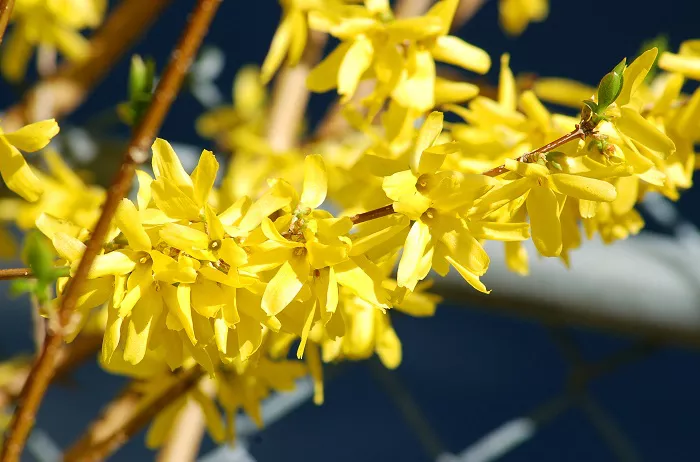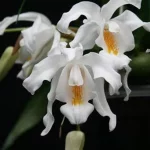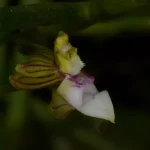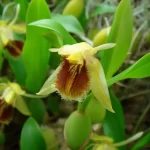Forsythia, with its radiant yellow blossoms, heralds the arrival of spring and is a symbol of renewal, hope, and the beauty of new beginnings. A shrub native to East Asia and parts of Europe, forsythia is widely loved for its early spring bloom, often blooming even before its leaves appear. This vibrant flowering shrub is more than just a seasonal herald—its rich symbolism spans across cultures and traditions. In this article, we will explore the meaning and symbolism of the forsythia flower, its various color meanings, its significance in the Bible, in tattoos, and its symbolic associations with love and death.
Forsythia Flower Symbolism
What Does Forsythia Flower Represent?
The forsythia flower, with its brilliant yellow petals, is an iconic symbol of spring and new beginnings. Often one of the first plants to bloom after the cold winter months, forsythia represents hope, renewal, and the cyclical nature of life. Its appearance signals the end of winter’s dormancy and the vibrant start of a new season, making it a powerful symbol of rebirth and fresh starts.
The forsythia flower is also associated with joy and happiness, as its bright yellow blooms seem to radiate warmth and light. In many cultures, forsythia symbolizes optimism, positive energy, and the potential for growth. Just as the flower’s early bloom marks the arrival of spring, it reminds people that even after difficult or challenging times, new opportunities and growth await.
Additionally, forsythia flowers can be seen as symbols of clarity and purpose. The bright yellow color often represents the clarity of thought and the shining light of enlightenment that comes with new beginnings. The forsythia, therefore, embodies the idea of opening up to new possibilities, embracing change, and finding one’s path toward success and fulfillment.
Forsythia Flower Meaning in Different Colors
The Meaning of Yellow Forsythia Flowers
Yellow is the primary color associated with forsythia flowers, and it holds deep symbolic meaning. Yellow forsythia flowers are most commonly seen as symbols of joy, optimism, and enlightenment. Their bright and sunny color evokes feelings of happiness and positivity, making them a popular choice for celebrations, springtime bouquets, and home decorations.
Yellow, in general, is associated with the sun, warmth, and light. Forsythia’s yellow blossoms are reminders of the dawn of new opportunities and the warmth that follows the darkness of winter. In a spiritual sense, yellow forsythia flowers represent the light of hope and clarity that dispels confusion and uncertainty, offering a sense of guidance for those in need of direction.
Additionally, yellow forsythia flowers are seen as symbols of friendship and affection. They are often given to convey appreciation or to celebrate the joy and optimism of a particular friendship. The color yellow also carries an association with mental clarity, intelligence, and creativity, so yellow forsythia flowers can symbolize the bright ideas and fresh perspectives that come with new beginnings.
The Meaning of Pink Forsythia Flowers
Though yellow is the most common color of forsythia flowers, pink forsythia blooms do exist, though they are less common. Pink forsythia flowers carry meanings related to love, compassion, and emotional warmth. While yellow forsythia flowers evoke joy and happiness, pink forsythia blooms tend to symbolize gentler emotions, such as affection, admiration, and tender love.
Pink flowers in general are associated with romance, sweetness, and nurturing care. Pink forsythia flowers, therefore, can serve as a symbol of a blossoming relationship or the appreciation of close connections with others. The pink hue may also represent emotional healing, bringing comfort and a sense of peace during difficult times.
Additionally, pink forsythia flowers could symbolize gratitude and the appreciation of beauty in life. In the same way that the yellow forsythia expresses joy and vitality, pink forsythia might represent the softer, nurturing side of the human experience—expressing kindness, support, and loving affection.
The Meaning of White Forsythia Flowers
White forsythia flowers, though rare, carry their own set of symbolic meanings. White flowers are traditionally associated with purity, innocence, and spiritual enlightenment. A white forsythia flower, therefore, could symbolize a fresh start or the idea of a new beginning grounded in clarity and purity of intent.
In a more spiritual context, white forsythia flowers might represent spiritual awakening or enlightenment. Just as the forsythia heralds the coming of spring, the white variety of the flower could be seen as a symbol of the new season of the soul—emerging into clarity and inner peace after a period of growth or challenge.
White flowers are also often linked to memorials and remembrance, so a white forsythia could represent the honoring of someone who has passed, especially if the person was known for their purity of heart or spirit.
Forsythia Flower Meaning in the Bible
The Biblical Significance of Forsythia
While forsythia is not specifically mentioned in the Bible, its symbolism can be linked to broader biblical themes of renewal, transformation, and hope. Flowers in the Bible are often used as metaphors for life’s transience, beauty, and divine creation. The Bible uses flowers to express the idea that life, like a flower, is fleeting but also beautiful and full of purpose.
For instance, in Isaiah 40:6-8, it is written: “All people are like grass, and all their faithfulness is like the flowers of the field. The grass withers and the flowers fall, but the word of our God endures forever.” This passage emphasizes the fleeting nature of life, yet points to the enduring nature of God’s promises. Forsythia flowers, with their brief but vibrant bloom, may symbolize the temporary nature of human life and the hope of eternal renewal found in God’s word.
Forsythia and Spiritual Growth
The appearance of forsythia in early spring can be viewed as a symbol of spiritual growth and the blossoming of faith. Just as the forsythia heralds the arrival of a new season, it can represent the spiritual awakening that often comes after a period of personal growth or transformation. Forsythia’s bright blooms remind us that, even in the midst of winter (whether literal or figurative), the promise of new life is always ahead.
In Christian spirituality, forsythia may also symbolize resurrection and renewal—concepts central to Easter and the promise of eternal life. Its vibrant blooms speak to the promise of new beginnings after times of hardship, a reflection of the hope Christians have in Christ’s resurrection and the renewal of life.
See Also: Firecracker Flower Symbolism and Meaning in Love, Death & Bible
Forsythia Flower Meaning in Tattoos
Forsythia Flowers in Tattoo Culture
Tattoos of forsythia flowers are relatively uncommon, but they carry deep meaning for those who choose them. Forsythia tattoos typically represent new beginnings, personal growth, and the embracing of positive change. Just as the forsythia flower blooms in early spring, a forsythia tattoo can symbolize the wearer’s own journey toward renewal, healing, and transformation.
The forsythia flower’s bright yellow color is a popular choice for tattoo designs because of its associations with joy, optimism, and energy. Those who choose a forsythia tattoo often seek to express their optimism for the future or commemorate a period of personal growth. A forsythia tattoo can be seen as a reminder of the beauty that can emerge from times of struggle, as well as a symbol of hope for the future.
The Placement of Forsythia Tattoos
Forsythia tattoos can be designed in a variety of styles, from delicate and detailed representations of the flowers to more abstract or geometric interpretations. The tattoo’s meaning and placement may vary depending on the wearer’s personal connection to the flower. Common placements for a forsythia tattoo include the wrist, forearm, ankle, or shoulder—areas that are visible and can serve as a constant reminder of the flower’s symbolic meanings.
A forsythia tattoo might be especially meaningful for someone who has gone through a transformative period in their life or someone who wants to commemorate a new beginning, such as the start of a new relationship, career, or phase in their spiritual journey.
Forsythia Flower Meaning in Love
Forsythia in Romantic Love
In the realm of love and relationships, forsythia flowers are symbolic of joy, renewal, and the celebration of love. Their vibrant yellow color and early spring bloom suggest a love that is full of warmth, vitality, and optimism. Forsythia flowers are often associated with new love, symbolizing the excitement and freshness that comes with the early stages of a relationship.
For those who are in a committed relationship, forsythia flowers can also symbolize the enduring strength of love. The flower’s ability to bloom year after year, despite external challenges, represents a love that is resilient and long-lasting. Just as forsythia returns each spring, so too does a committed love that grows and flourishes with time.
Forsythia and Friendship in Love
In addition to romantic love, forsythia flowers are also symbols of friendship and affection. The flower’s cheerful and welcoming appearance makes it an ideal representation of close bonds and joyful connections. In friendships, forsythia can symbolize the warmth and happiness that come from being surrounded by supportive and caring individuals.
Giving someone a bouquet of forsythia flowers may also be a gesture of appreciation for their companionship, loyalty, and love. The flower’s bright yellow petals represent the joy that friends bring into our lives and the shared moments of happiness that define meaningful relationships.
Forsythia Flower Meaning in Death
Forsythia and the Cycle of Life
The forsythia flower, with its brief but stunning bloom, has also been linked to the cycle of life and death. The flower’s short-lived blossoms serve as a reminder of the impermanence of life and the beauty that can be found in every moment. Just as forsythia blooms herald the arrival of spring, they also remind us that life is a continual cycle of birth, growth, and eventual death.
In this context, forsythia can symbolize the fleeting nature of life and the inevitability of change. It encourages us to cherish every moment and to recognize that even in times of loss, new beginnings are always on the horizon.
Forsythia in Memorials
Though less common than other flowers, forsythia can be used in memorial services to symbolize the life and spirit of someone who has passed. Its vibrant color and early spring bloom may represent the deceased person’s enduring legacy and the way in which their spirit continues to live on, just as the forsythia returns year after year.
Forsythia flowers in a memorial context might also symbolize hope and the idea that life continues in different forms, even after death. Their bright color reminds us of the beauty that remains in the world and the possibility of new beginnings, even in the face of loss.
Conclusion
The forsythia flower, with its golden yellow petals and early spring bloom, is a powerful symbol of renewal, joy, and hope. Whether representing new beginnings, the resilience of love, or the beauty of life’s cyclical nature, the forsythia has deep meaning across a variety of contexts. From its use in tattoos to its associations with the Bible and its significance in the realms of love and death, forsythia serves as a reminder that, just as the seasons change, we too can experience growth, healing, and transformation. Its vibrant blossoms, heralding the arrival of spring, encourage us to embrace the promise of new opportunities, positive change, and a future filled with light and possibility.
Related topics:













